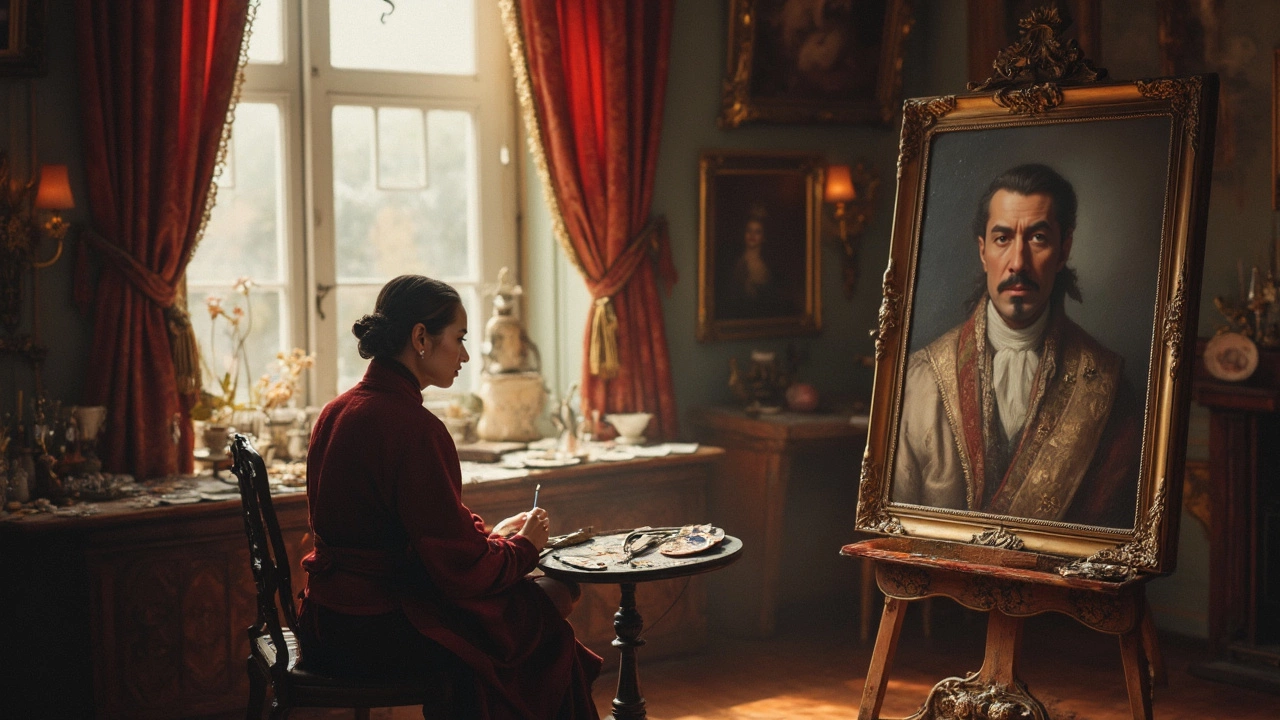Did you know that portrait painting can be one of the most bankable artistic ventures out there? Yup, I'm talking about the kind of art that captures someone's spirit on canvas, not just their looks. Whether you're painting famous figures or Grandma Mary, portraits have this timeless charm that people can't resist. Plus, they’re a fantastic way for artists to tap into a market that craves personal and custom works. Let's dig into why portraits are such hot sellers.
First off, portraits are super personal. People love to see themselves or their loved ones captured in a meaningful way. It’s not just art; it's about cherishing memories or celebrating identities. And who doesn't want something that speaks directly to them and holds sentimental value? This intrinsic appeal makes them easy to sell if you know your stuff.
- Why Portraits Are Profitable
- Understanding Your Audience
- Techniques to Enhance Appeal
- Marketing and Selling Strategies
Why Portraits Are Profitable
Alright, so why exactly are portraits rocking the art sales charts? Well, for starters, they tap into something deeply personal and sentimental. People love to celebrate milestones, remember loved ones, or just showcase someone special on their walls. This is where the magic of portrait painting comes in—capturing not just a face, but essence and emotion. That's a product not easily found in the mass-produced art world.
The market supports it, too. Imagine you’re at an art fair. There's a sea of abstract art, landscapes, and everything in between. But when someone sees a beautifully crafted portrait, it seems to just leap off the wall. It's relatable and engages viewers on a personal level. Artists find success because of this strong personal connection, which is why portraits remain a profitable venture.
On a more practical note, portrait painting often allows for higher price points. Customization adds unique value—each piece is one-of-a-kind, made specifically for the buyer. People are willing to spend more for something personal and exclusive. Not to mention, it opens up additional revenue streams like commissions, which can be super lucrative for artists who've built a solid reputation.
Let's break it down with some stats: a recent report showed commissioned artworks, especially portraits, can have a profit margin of over 50%. Some artists even command prices in the thousands for a single piece! It's a bang for the buck scenario—you're creating meaningful art and getting well-rewarded.
| Type of Portrait | Average Selling Price |
|---|---|
| Oil on Canvas | $1,500 - $5,000 |
| Digital Portrait | $200 - $1,500 |
| Charcoal Sketch | $100 - $500 |
In conclusion, portrait painting isn’t just about wielding a brush—it’s about understanding people and capturing something that matters to them. Whether you're just starting out or you've been painting for years, investing your time in portraits could be your ticket to a rewarding art career.
Understanding Your Audience
If you want to succeed in portrait painting, knowing your audience is clutch. Seriously, who are you painting for? It’s not just about slapping paint on canvas; it’s about making connections through your work. Portraits are super personal, and that means the person buying it wants to feel a connection to what they're seeing.
First things first, identify who's interested in owning portraits. Portrait painting attracts everyone from families wanting a legacy piece to businesses sprucing up their spaces with art. Each of these groups has different needs and expectations. For example, a family might want something warm and personal, while a business may be looking for something classical and professional.
Start by checking out local markets and galleries. Who's buying and what styles are flying off the shelves? Pay attention to age groups too. Millennials might be drawn to more modern, edgy styles, while older generations might prefer those classic approaches. Oh, and let’s not forget social media! Platforms like Instagram are a treasure trove for scoping out potential clients and understanding trends.
The Google search can shed some light as well. Looking at what art market trends are popular can help you determine what clients might expect from commissioned pieces. Artists who get this right often have a waiting list of folks eager for their work, allowing for continual business flow.
For example, did you know that in a survey of art buyers, 40% preferred art that brings personal and emotional value? Exactly. Tailoring your services to this mindset can help you hit the sweet spot where demand aligns with your passion.
In short, by really understanding what your audience wants and speaking to their needs, you’re not just creating art—you’re building relationships. And in the profitable art world, that’s where the magic happens.

Techniques to Enhance Appeal
So you want to make your portrait painting irresistible, huh? You’re on the right track. Getting that perfect blend of skill and creativity is key to boosting your art’s appeal. Here’s how you can level up your game.
First thing’s first, let's talk about lighting. It's one of the unsung heroes in portrait painting. Good lighting sets the mood and highlights facial features just right. Play around with different lighting settings—like Rembrandt or chiaroscuro—to see how they affect your work.
Next up, color choices. Using the right colors can evoke emotion and bring life to a portrait. Warm tones can give off a welcoming vibe, while cooler tones can make things feel more serene. Understand the psychological impact of colors on your audience to make informed choices.
Got any reference photos? Always use a high-quality photo to work from. A detailed picture can make a real difference because it gives you all the little details you might miss otherwise. If you're working from life, arrange extra studio lights to get that quality up a notch.
Let’s not forget about practicing proper anatomy. Understanding facial structure is vital. Artists often use basic geometric shapes to map out the face initially, then add layers of detail for realism. Yep, practice makes perfect!
Lastly, your own unique touch makes a world of difference. Maybe it's the way you use brush strokes or the specific texture you create—it's often these small, distinctive techniques that make an artist stand out. Experimenting with these can set you apart from the crowd. Plus, signature styles are gold in the art market.
Marketing and Selling Strategies
So, you're into portrait painting and want to turn it into a profitable gig? Let’s get down to the nitty-gritty of marketing and selling your art.
First things first, know who your buyers are. Are they art collectors, galleries, or people wanting a family portrait? Once you’ve nailed that, you can tailor your strategy to match their vibe. Social media is your best friend here. Platforms like Instagram are gold mines for artists. By showcasing your work regularly, interacting with followers, and using the right hashtags, you can create a strong online presence that attracts potential customers.
Don’t underestimate the power of a good website. Having an online portfolio where fans can not only browse your pieces but also easily contact you for commissions is crucial. It’s like your personal gallery open 24/7. Make sure to list your prices—a lot of artists hesitate, but transparency here builds trust.
Networking is another key piece of this puzzle. Connect with other artists, attend gallery openings, or join local art groups. Getting your face out there and building relationships can lead to opportunities you might not find online. Consider entering competitions or exhibitions as well. It’s more than just exposure; winning or even participating adds credibility to your work.
Consider offering limited edition prints of your most popular pieces. This allows fans who can't afford an original portrait to still own your work, broadening your customer base and keeping the cash flow steady.
| Marketing Channel | Effectiveness |
|---|---|
| High | |
| Website Portfolio | High |
| Networking Events | Medium |
| Art Competitions | Variable |
Finally, remember to focus not just on selling but also on building relationships. Satisfied customers often come back for more or recommend you to their friends. An effective word-of-mouth strategy can be powerful, especially when backed by positive customer experiences. Follow up on completed works and ask for feedback or testimonials. These not only help improve your service but also work as social proof for future clients.







